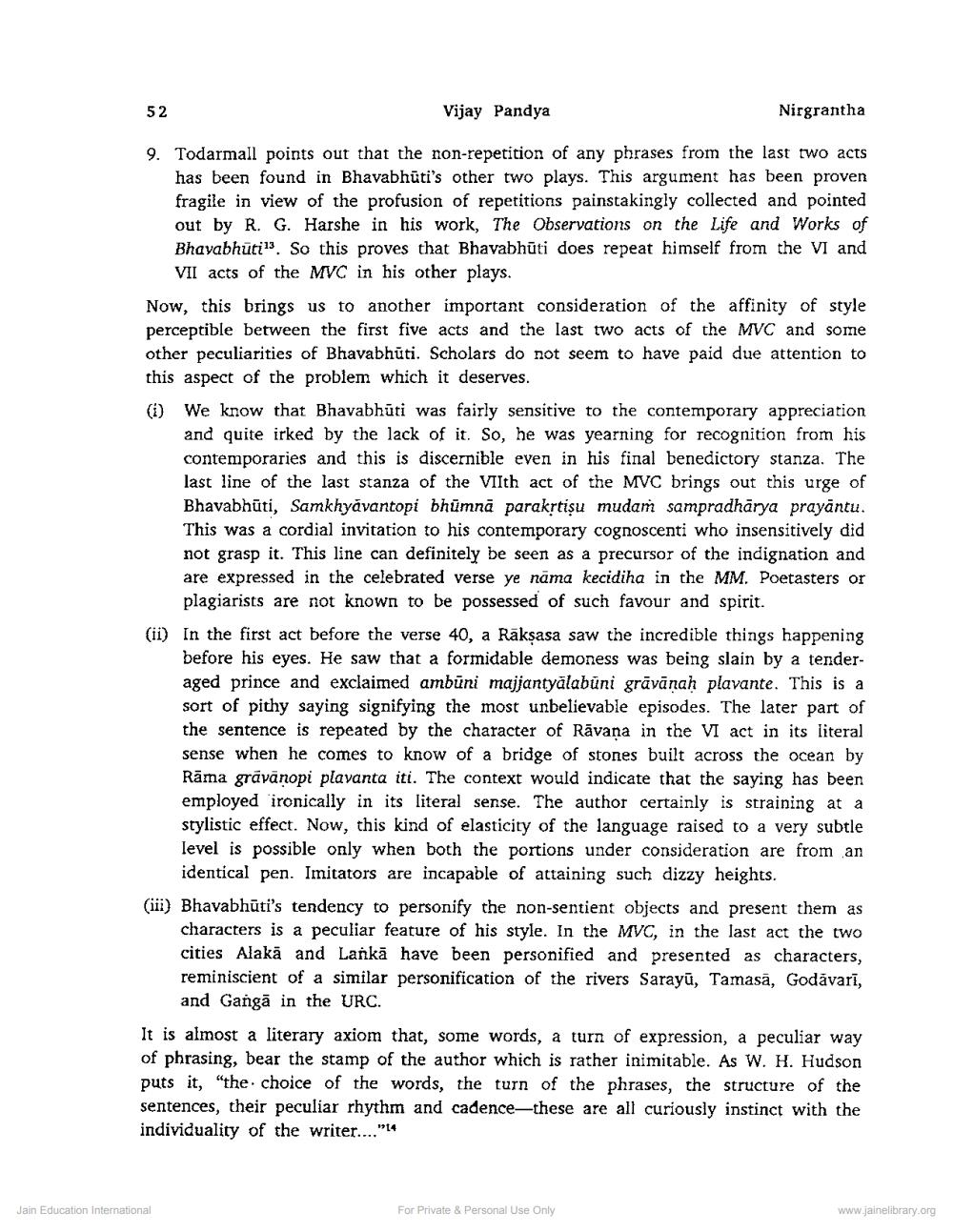Book Title: Text of Mahavircarita of Bhavbhuti Author(s): Vijay Pandya Publisher: Z_Nirgrantha_1_022701.pdf and Nirgrantha_2_022702.pdf and Nirgrantha_3_022703.pdf View full book textPage 5
________________ Vijay Pandya Nirgrantha 9. Todarmall points out that the non-repetition of any phrases from the last two acts has been found in Bhavabhuti's other two plays. This argument has been proven fragile in view of the profusion of repetitions painstakingly collected and pointed out by R. G. Harshe in his work, The Observations on the Life and Works of Bhavabhūti". So this proves that Bhavabhūti does repeat himself from the VI and VII acts of the MVC in his other plays. 52 Now, this brings us to another important consideration of the affinity of style perceptible between the first five acts and the last two acts of the MVC and some other peculiarities of Bhavabhuti. Scholars do not seem to have paid due attention to this aspect of the problem which it deserves. (i) We know that Bhavabhuti was fairly sensitive to the contemporary appreciation and quite irked by the lack of it. So, he was yearning for recognition from his contemporaries and this is discernible even in his final benedictory stanza. The last line of the last stanza of the VIIth act of the MVC brings out this urge of Bhavabhūti, Samkhyāvantopi bhūmnā parakṛtiṣu mudam sampradhārya prayāntu. This was a cordial invitation to his contemporary cognoscenti who insensitively did not grasp it. This line can definitely be seen as a precursor of the indignation and are expressed in the celebrated verse ye nama kecidiha in the MM. Poetasters or plagiarists are not known to be possessed of such favour and spirit. (ii) In the first act before the verse 40, a Räkṣasa saw the incredible things happening before his eyes. He saw that a formidable demoness was being slain by a tenderaged prince and exclaimed ambûni majjantyālabūni gräväṇaḥ plavante. This is a sort of pithy saying signifying the most unbelievable episodes. The later part of the sentence is repeated by the character of Ravana in the VI act in its literal sense when he comes to know of a bridge of stones built across the ocean by Rāma grāvāṇopi plavanta iti. The context would indicate that the saying has been employed ironically in its literal sense. The author certainly is straining at a stylistic effect. Now, this kind of elasticity of the language raised to a very subtle level is possible only when both the portions under consideration are from an identical pen. Imitators are incapable of attaining such dizzy heights. (i) Bhavabhuti's tendency to personify the non-sentient objects and present them as characters is a peculiar feature of his style. In the MVC, in the last act the two cities Alaka and Lanka have been personified and presented as characters, reminiscient of a similar personification of the rivers Sarayu, Tamasā, Godāvarī, and Ganga in the URC. It is almost a literary axiom that, some words, a turn of expression, a peculiar way of phrasing, bear the stamp of the author which is rather inimitable. As W. H. Hudson puts it, "the choice of the words, the turn of the phrases, the structure of the sentences, their peculiar rhythm and cadence-these are all curiously instinct with the individuality of the writer...." Jain Education International For Private & Personal Use Only www.jainelibrary.orgPage Navigation
1 ... 3 4 5 6 7 8 9
